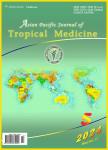Molecular survey of tick-borne pathogens in Ixodid ticks collected from hunted wild animals in Tuscany, Italy
Molecular survey of tick-borne pathogens in Ixodid ticks collected from hunted wild animals in Tuscany, Italy作者机构:Department of Veterinary Science University of Pisa
出 版 物:《Asian Pacific Journal of Tropical Medicine》 (亚太热带医药杂志(英文版))
年 卷 期:2015年第8卷第9期
页 面:702-705页
核心收录:
学科分类:090601[农学-基础兽医学] 1002[医学-临床医学] 09[农学] 0906[农学-兽医学]
基 金:funds from the University of Pisa
主 题:Ixodid ticks Tick-borne bacteria Wild animals PCR Hunters
摘 要:Objective: To determine the prevalence of zoonotic tick-borne bacteria in feeding ticks removed from hunted wild animals. Methods: PCR was executed on DNA extracted from 77 tick pools to detect Anaplasma phagocytophilum, Bartonella spp., Borrelia burgdorferi sensu lato, Coxiella burnetii and Rickettsia spp. Results: A total of 432 ticks were collected: 30(6.94%) Haemaphysalis punctata, 72(16.7%) Dermacentor marginatus and 330(76.38%) Ixodes ricinus. For each animal one or two pools of 3 ticks of the same species was constituted. Seventy-seven tick pools were examined by PCR: 58(75.32%) resulted infected and among them 14(18.18%) showed co-infections. In particular, 29(37.66%) pools were positive for Bartonella spp., 23(29.87%) for Anaplasma phagocytophilum, 16(20.78%) for Rickettsia spp., and 5(6.49%) for Borrelia burgdorferi s.l. All samples were negative for Coxiella burnetii. Conclusions: The results demonstrate the presence of several zoonotic tick-borne pathogens in the studied area, and underline the risk of exposure to infections for hunters not only during the outdoor activity, but also when they manipulate hunted animals infested by infected ticks.



